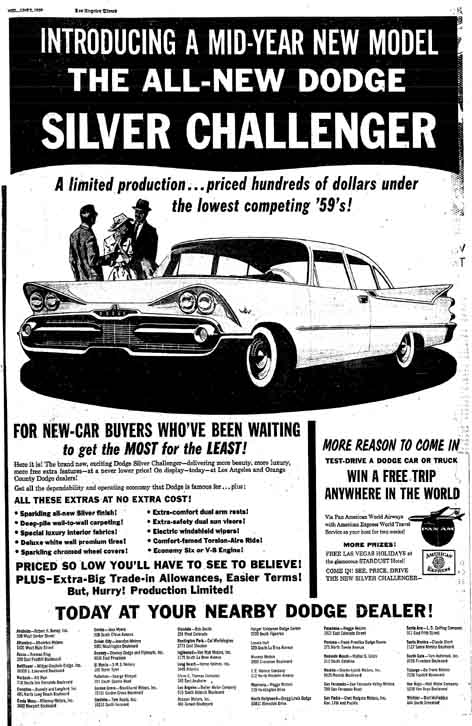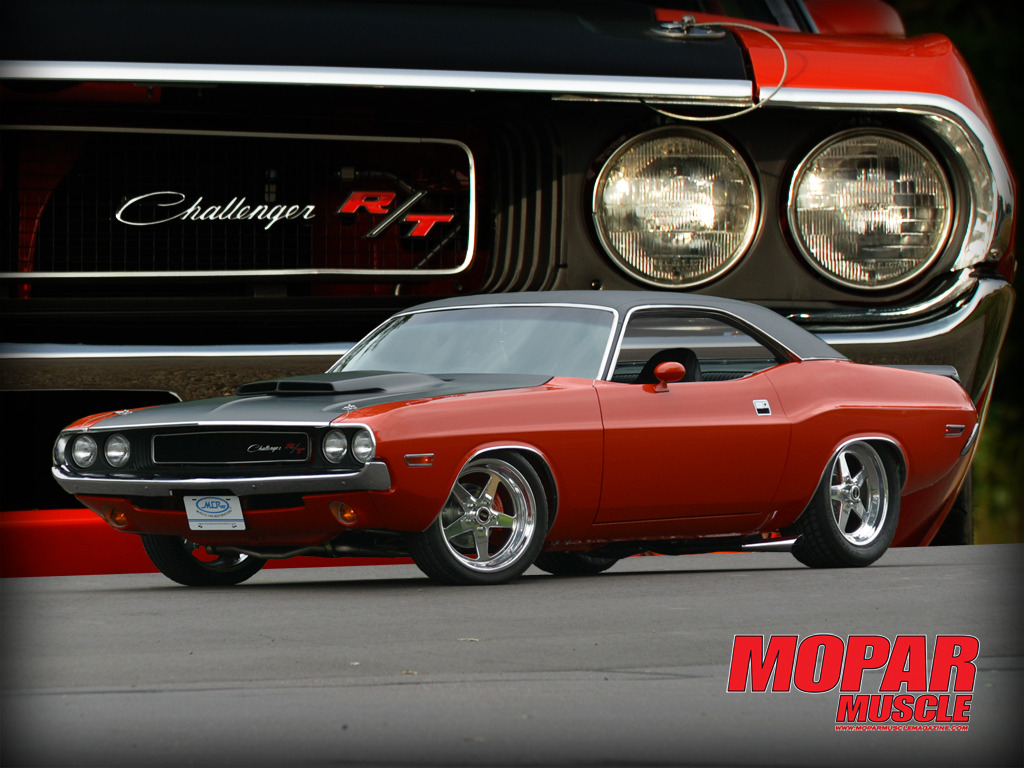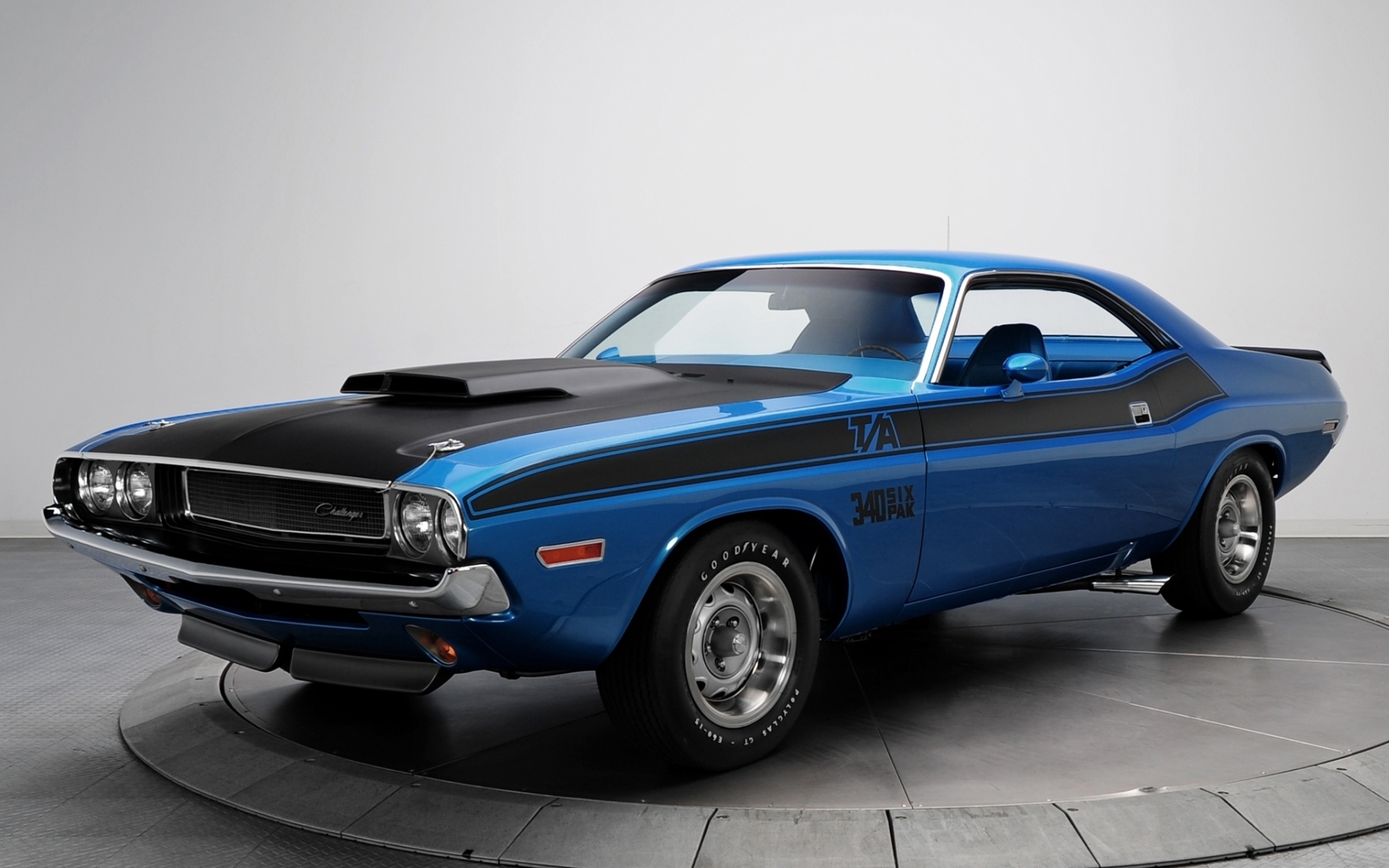Post by ferrari512s on May 31, 2014 9:44:34 GMT -5

The first car that carried the Challenger name was the introduction of a limited edition Dodge Silver Challenger Club Sedan to the 1959 full-sized Dodge Coronet (fourth generation) model line.[1]

The Silver Challenger came only in silver paint and exclusively on Chrysler's 217.4 in (5,520 mm) long two-door body style riding on a 122.0 in (3,100 mm) wheelbase. It was available with either the 230 cu in (3.8 L) "Getaway" L-head straight-six engine for $2,297, or powered by the 325 cu in (5.3 L) "Red Ram" V8 for $2,408.[1]

This car was marketed for the spring selling season to the "new-car buyers who've been waiting to get the most for the least."[2] A column-shifted three-speed manual transmission was standard and an automatic was optional.

The 1959 Silver Challenger was marketed with extra features at no extra cost. These included premium white wall tires, full wheel covers, electric windshield wipers, as well as an upgraded interior with silver metallic vinyl and black "Manchu" fabric upholstery, dual arm rests and sun visors, as well as deep pile wall-to-wall carpeting.[2][3]

First generation (1970–1974)
The Challenger was described in a book about 1960s American cars as Dodge's "answer to the Mustang and Camaro."[5] Introduced in fall 1969 for the 1970 model year,[5] it was one of two Chrysler E-body cars, the other being the slightly smaller Plymouth Barracuda.

"Both the Challenger and Barracuda were available in a staggering number of trim and option levels" and were intended "to compete against cars like the Chevrolet Camaro and Ford Mustang, and to do it while offering virtually every engine in Chrysler's inventory."[6]

However, the Challenger was "a rather late response to the ponycar wave the Ford Mustang had started."[7]

In his book Hemi Muscle Cars,[8] Robert Genat wrote that the Challenger was conceived in the late 1960s as Dodge's equivalent of the Plymouth Barracuda, and that the Barracuda was designed to compete against the Mustang.

The Barracuda was actually the first car in this sporty car segment by a few months, but was quickly overshadowed by the release of the segment defining Mustang (the segment being referred to as "Pony Car").

He added that Chrysler intended the new Dodge as "the most potent ponycar ever," and positioned it "to compete against the Mercury Cougar and Pontiac Firebird."

Genat also noted that the "Barracuda was intended to compete in the marketplace with the Mustang and Camaro/Firebird, while the Dodge was to be positioned against the Cougar" and other more luxury-type musclecars.[9]

The Challenger's longer wheelbase, larger dimensions and more luxurious interior were prompted by the launch of the 1967 Mercury Cougar, likewise a bigger, more luxurious and more expensive pony car aimed at affluent young American buyers.[10]

The wheelbase, at 110 inches (2,794 mm), was two inches longer than the Barracuda, and the Dodge differed substantially from the Plymouth in its outer sheetmetal, much as the Cougar differed from the shorter-wheelbase Ford Mustang. A/C and a rear window defogger were optional.[11]

Exterior design was done by Carl Cameron, who also did the exterior for the 1966 Dodge Charger. Cameron based the 1970 Challenger grille off an older sketch of his 1966 Charger prototype that was to have a turbine engine.

The Charger never got the turbine, but the Challenger got that car's grille. Although the Challenger was well received by the public (with 76,935 produced for the 1970 model year), it was criticized by the press, and the pony car segment was already declining by the time the Challenger arrived.

Sales fell dramatically after 1970, and though sales rose for the 1973 model year with over 27,800 cars being sold, Challenger production ceased midway through the 1974 model year. 165,437 Challengers were sold over this model's lifespan.

A 1970 Challenger R/T 440 Magnum is the centerpiece of the existentialist 1971 film Vanishing Point.[12]

Models

1970 Dodge Challenger R/T coupe with a 426-cubic inch engine
Four hardtop models were offered: Challenger Six, Challenger V8, Challenger T/A (1970 only), and Challenger R/T with a convertible version available only in 1970 and 1971.

Although there were no factory-built R/T Challenger convertibles for 1971, the R/T continued as a model with the hardtop body-style.

The standard engine on the base model was the 225 cu in (3.7 L) six-cylinder. The standard engine on the V8 was the 230 bhp (171.5 kW)318 cu in (5.2 L) V8 with a 2-barrel carburetor.

Optional engines were the 340 and 383 cu in (5.6 and 6.3 L) V8s, all with a standard 3-speed manual transmission, except for the 290 bhp (216.3 kW) 383 CID engine, which was available only with the TorqueFlite automatic transmission.
A 4-speed manual was optional on all engines except the 225 CID I6 and the 2-barrel 383 CID V8.

The performance model was the R/T (Road/Track), with a 383 CID Magnum V8, rated at 335 bhp (249.8 kW); 300 bhp (223.7 kW) for 1971, due to a drop in compression.

The standard transmission was a 3-speed manual. Optional R/T engines were the 375 bhp (279.6 kW) 440 cu in (7.2 L) Magnum, the 390 bhp (290.8 kW) 440 CID Six-Pack and the 425 bhp (316.9 kW) 426 cu in (7.0 L) Hemi.

The R/T was available in either the hardtop or convertible. For 1970 only, base hardtop and R/T hardtop models could be ordered with the more luxurious SE specification, which included leather seats, a vinyl roof, a smaller 'formal' rear window, and an overhead interior console that contained three warning lights (door ajar, low fuel, and seatbelts).[13]

The Challenger R/T came with a Rallye instrument cluster that included a 150 mph (240 km/h) speedometer, an 8,000 rpm tachometer,[14] 1972–1974 tachometer went to 7,000 rpm and an oil pressure gauge.

In 1972, the R/T badging was dropped and these models were called "Rallye", although they were never badged as such.

The Rallye model featured a faux brake vent on the fenders. The shaker hood scoop was not available after 1971.
SE "formal" rear window

A 1970-only model was the Dodge Challenger T/A (Trans Am) racing homologation car.

In order to race in the Sports Car Club of America's Trans American Sedan Championship Trans Am, Dodge built a street version of its race car (just like Plymouth with its Plymouth 'Cuda AAR) which it called the Dodge Challenger T/A (Trans Am).

Although the race cars ran a destroked version of the 340, street versions took the 340 and added a trio of two-barrel carburetors atop an aluminum intake manifold, creating the 340 Six Pack.

Dodge rated the 340 Six Pack at 290 bhp (216.3 kW), only 15 bhp (11 kW) more than the original 340 engine (which also had the same rating as the Camaro Z/28 and Ford Boss 302 Mustang).

The engine actually made about 320 bhp (238.6 kW). It breathed air through a suitcase sized air scoop molded into the pinned down, hinged matte-black fiberglass hood. Low-restriction dual exhaust ran to the stock muffler location, then reversed direction to exit in chrome tipped "megaphone" outlets in front of the rear wheels.

Options included a TorqueFlite automatic or pistol-grip Hurst-shifted four-speed transmission, 3.55:1 or 3.90:1 gears, as well as manual or power steering. Front disc brakes were standard. The special Rallye suspension used heavy duty parts and increased the rate of the rear springs.

The T/A was the first U.S. muscle car to fit different size tires front and rear to give a racing stance: E60x15 in the front, and G60x15 in the rear. The modified chamber elevated the tail enough to clear the rear rubber and its side exhaust outlets.

Thick dual side stripes, bold ID graphics, a fiberglass ducktail rear spoiler, and a fiberglass front spoiler added to the racing image. The interior was strictly stock Challenger.

Dodge contracted Ray Caldwell's Autodynamics firm in Marblehead, Massachusetts to run the factory Trans-Am team. Sam Posey drove the No.77 "sub-lime" painted car that Caldwell's team built from a car taken off a local dealer's showroom floor.

When the No.76 was completed mid-season from a chassis provided by Dan Gurney's All American Racers, Posey alternated between the two. Both cars ran the final two races, with Posey in the #77. Ronnie Bucknum drove the No.76 at Seattle Washington, and Tony Adamowicz drove it at Riverside, California.

The Challenger T/A's scored a few top three finishes, but lack of a development budget and the short-lived Keith Black 303 c. i. engines led to Dodge leaving the series at season's end.

Source
en.wikipedia.org/wiki/Dodge_Challenger

Dodge Challanger Models and Die-cast Releases
DRAFT...

